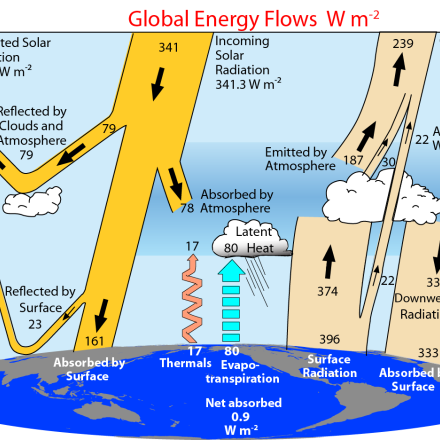Budgets: Mass, Moisture, Energy

The uneven distribution of incoming and outgoing radiation is the primary driver of the climate system. The resulting flows of energy by the climate components (atmosphere, ocean, ice, etc) determine the climate. Ultimately, the net difference between incoming and outgoing radiation determines if the climate is changing. Hence, estimating and understanding energy transports is essential for current climate assessment and future prospects.
Cite this page
Acknowledgement of any material taken from or knowledge gained from this page is appreciated:
National Center for Atmospheric Research Staff (Eds). Last modified "The Climate Data Guide: Budgets: Mass, Moisture, Energy.” Retrieved from https://climatedataguide.ucar.edu/climate-data/budgets-mass-moisture-energy on 2025-12-20.
Citation of datasets is separate and should be done according to the data providers' instructions. If known to us, data citation instructions are given in the Data Access section, above.
Acknowledgement of the Climate Data Guide project is also appreciated:
Schneider, D. P., C. Deser, J. Fasullo, and K. E. Trenberth, 2013: Climate Data Guide Spurs Discovery and Understanding. Eos Trans. AGU, 94, 121–122, https://doi.org/10.1002/2013eo130001
Key Figures
Other Information
- Trenberth, K. E. and J. T. Fasullo, 2011: Tracking Earth's energy: From El Niño to global warming. Surveys in Geophysics, Special Issue
- Trenberth, K. E., J. T. Fasullo, and J. Mackaro, 2011: Atmospheric moisture transports from ocean to land and global energy flows in reanalyses. J. Climate, 24, 4907-4924
- Trenberth, K.E. & D.Stepaniak (2004): The flow of energy through the earth’s climate system. Q. J. R. Meteorol. Soc. (2004), 130, pp. 2677–2701
- Matthew D. Palmer. (2012) Climate and Earth’s Energy Flows. Surveys in Geophysics Online publication date: 3-Feb-2012
- Kiehl JT, Trenberth KE (1997) Earth’s annual global mean energy budget. Bull Am Meteor Soc 78:197–208
- Wang, K., and R. E. Dickinson (2012), A review of global terrestrial evapotranspiration: Observation, modeling, climatology, and climatic variability, Rev. Geophys., 50, RG2005
